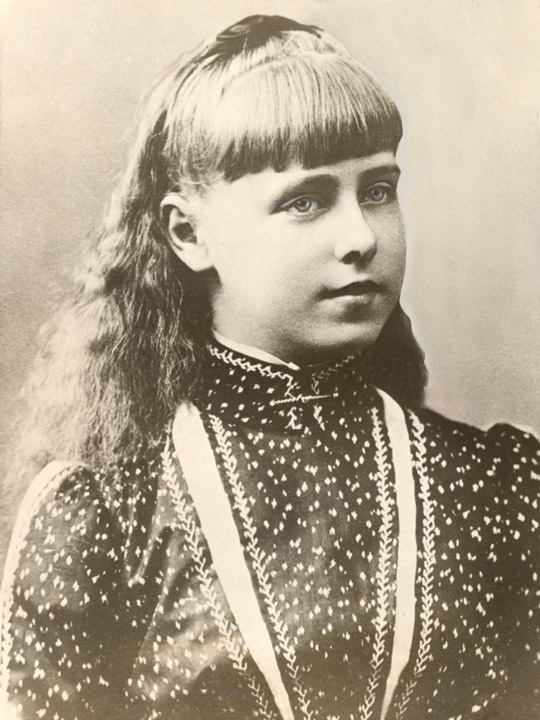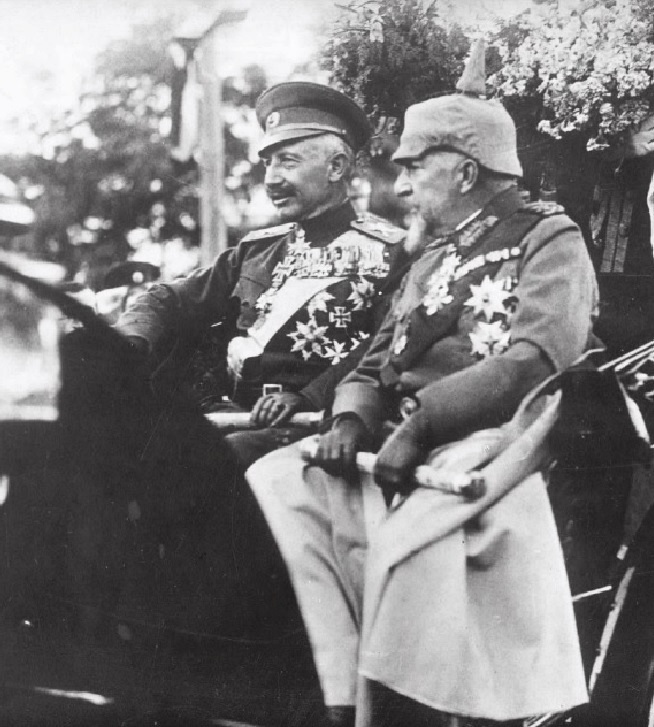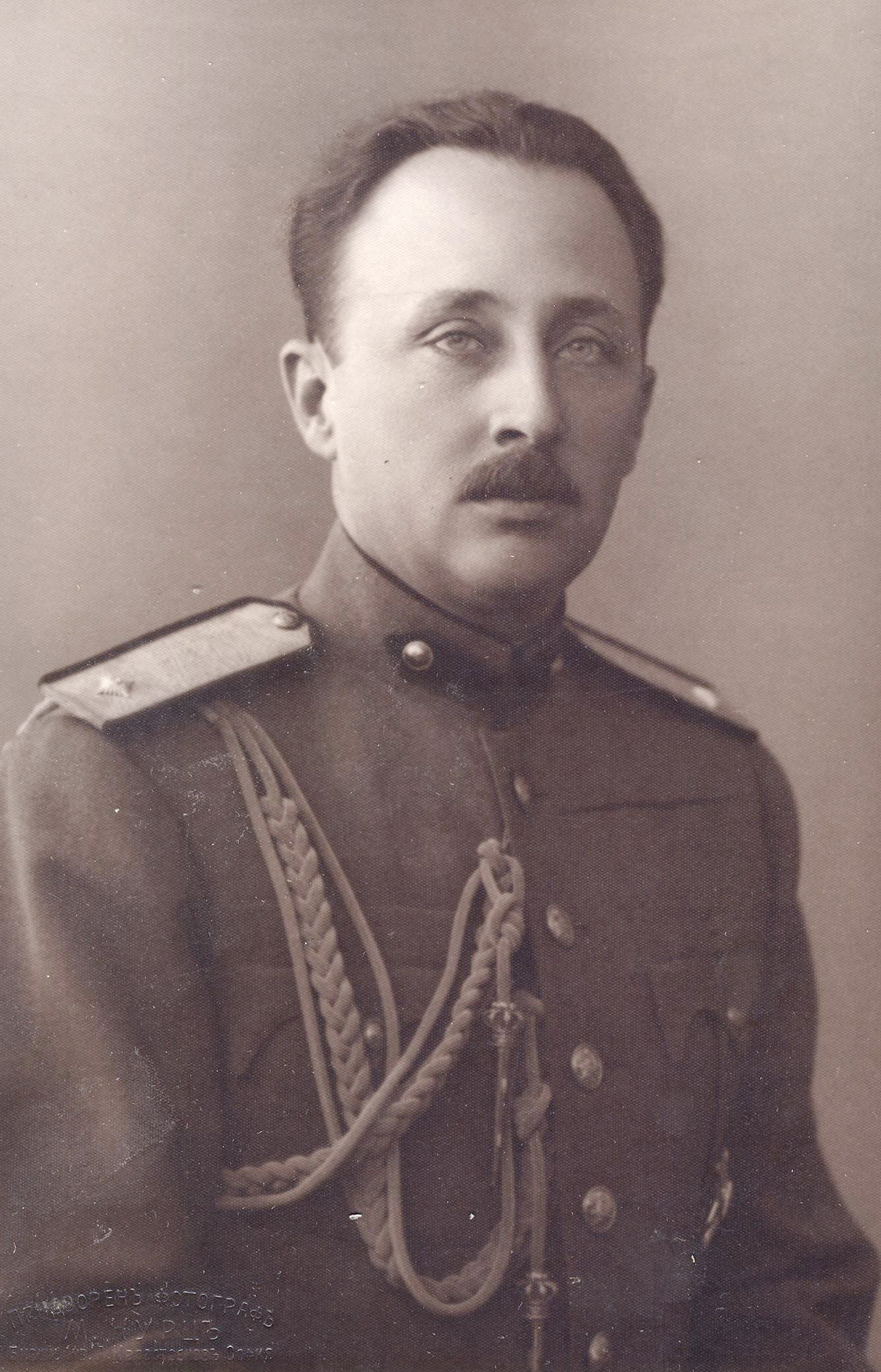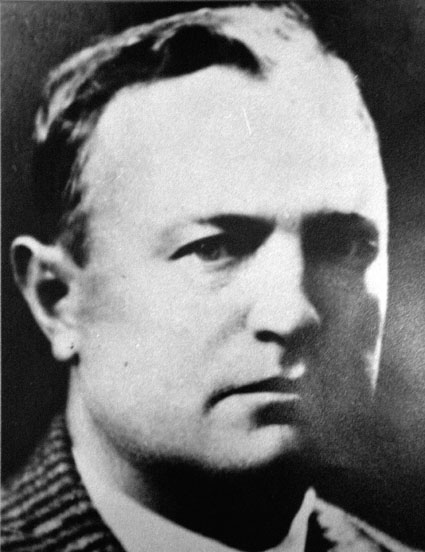La princesa Eudoxia (a veces llamada Eudoxie ) Augusta Filipina Clementina María de Bulgaria nació el 17 de enero de 1898 en Sofía, la capital del reino de su padre. Los padres de Eudoxia fueron el príncipe Fernando de Bulgaria (1861-1948; de soltera Sajonia-Coburgo y Gotha) y su esposa, la princesa María Luisa de Borbón-Parma (1870-1899): Fernando y María Luisa se casaron en la Villa Pianore, una propiedad del inmensamente rico padre de la novia, el duque de Parma, el 20 de abril de 1893. Eudoxia se unió a dos hermanos mayores, el príncipe Boris (1894-1943) y el príncipe Kyril (1895-1945); a la princesa le siguió un año después de su llegada la última de los cuatro hijos, la princesa Nadejda (1899-1958).
 |
| El príncipe Fernando y la princesa María Luisa de Bulgaria |
La búsqueda de esposa por parte de Fernando había comenzado en 1890, después de que se hiciera evidente que la situación política en Bulgaria era tensa mientras su soberano no tuviera herederos. Fernando había sido elegido Príncipe de Bulgaria en julio de 1887 después de la deposición del Príncipe Alejandro de Bulgaria (1857-1893; né Battenberg). El historiador británico Theo Aronson, en su libro Crowns in Conflict (Coronas en conflicto) , recordó la reacción de la prima de Fernando, la Reina Victoria, ante el ascenso de su pariente al Principado de Bulgaria: “ Es totalmente inadecuado... delicado, excéntrico y afeminado... Debería ser detenido de inmediato ”. Afortunadamente, con el tiempo, la opinión de la Reina sobre su primo mejoraría. Fernando perseveró, y su madre, la Princesa Clémentine, fue extremadamente instrumental en la defensa de los intereses de su hijo.
 |
| Archiduquesa Luisa de Austria-Toscana |
In 1890, Prince Ferdinand of Bulgaria was twenty-nine: he was fairly good looking, rich, and had impeccable family ties. The first candidate chosen for Ferdinand by his mother was his cousin Archduchess Luisa of Austria-Tuscany (1870-1947; later Crown Princess of Saxony), the daughter of Grand Duke Ferdinando IV of Tuscany (1835-1908) and his second wife Princess Alicia of Bourbon-Parma (1849-1935), who was herself an aunt of Ferdinand’s future wife Marie Louise. Needless to say, Ferdinand’s wooing in June 1891 of Luisa of Tuscany was not successful, which was probably for the best. Although Luisa’s father the grand duke (impoverished as he was) was in favour of the marriage, her mother Grand Duchess Alicia was decidedly not – the grand duchess had no love lost for the Coburgs.
 |
| Princess Marie of Saxe-Coburg and Gotha in 1888 |
Next on Ferdinand’s radar was one of the daughters of the Duke and Duchess of Saxe-Coburg and Gotha (Prince Alfred, Duke of Edinburgh, and his wife Grand Duchess Maria Alexandrovna of Russia). Presumably, the object of the prince’s “affections” was Princess Marie, the eldest daughter at age sixteen…though which of the daughters was never specified. Ferdinand mused in a letter: “…granddaughter of the Queen of England, granddaughter of the Tsar-liberator and cousin of the German Kaiser! Que voudrait on de plus. That would be a terrible blow for the Russophil part in this country – it would be forced to be loyal to the granddaughter of Alexander II! I see from the Coburg newspapers that the respective parents are already at Coburg. May God give them wisdom, for I am thoroughly sick of this marriage question and long for a result! I do not fear the father: he would agree out of hatred for Russia. But as for the mother? Will she have the good sense to defy her pig-headed and odious brother?” Given the youth of the young ladies involved, it would come as no surprise that no engagement emanated from Ferdinand’s daydreams on the subject. His search would have to continue.
 |
| Princess Clara of Bavaria |
Finally, in late 1892, the prince found his princess…after beating around the bush quite a bit. Princess Clémentine had been in contact with Duke Roberto of Parma, who had lost his duchy in 1860, for sometime; Clémentine realised that the duke’s daughter Marie Louise might offer the solution to Ferdinand’s marital dilemma. Religion was to play a major part in the negotiations for Marie Louise’s hand. Although the Bulgarian constitution required that the heir to the throne must be raised in the Orthodox faith, Duke Roberto demanded that this stipulation would have to be cast aside if Ferdinand were to marry Marie Louise: the duke made it clear that all issue of the marriage must be raised as Roman Catholic At the time, Ferdinand agreed, and was able to have his government acquiesce that the heir to the Bulgarian throne did not need to be baptised in the Orthodox church. With this carte blanche from his government, Ferdinand made one last attempt to snag a Catholic princess from a reigning dynasty. He traveled to Munich to briefly engage Princess Clara of Bavaria (1874-1941), but, again, he met with no success, as the Bavarian Prince Regent forbade any of the Wittelsbach princesses from accepting Ferdinand’s proposal. And, so, Ferdinand returned to the prospect of Marie Louise. Their engagement was celebrated at the Castle of Schwartzau: it was the first time that either of the pair had laid eyes on the other. Princess Clémentine was rather forward in describing her future daughter-in-law: “[She is] unhappily not very pretty.” Thus began the marriage of convenience of Ferdinand and Marie Louise; neither person in love with the other.
 |
| The wedding of Ferdinand of Bulgaria and Marie Louise of Bourbon-Parma |
 |
| Princess Marie Louise of Bulgaria |
At their wedding at the Villa Pianore, Marie Louise appeared in flowing white, her veil held by a fleur-de-lis tiara: she looked fragile and small next to her husband in his uniform. Pope Leo XIII gave a blessing to the couple via the Archbishop of Lucca. Ferdinand addressed his father-in-law the Duke of Parma by saying, “Bulgaria is grateful to you for having confided your daughter to her Prince. Bulgaria will honour her and guard her like a treasure.” The princely couple then set off for a honeymoon cruise around the Mediterranean.
 |
| Prince Ferdinand and Princess Marie Louise of Bulgaria with Princess Clémentine of Saxe-Coburg and Gotha |
 |
| (left to right) Princess Clémentine of Saxe-Coburg and Gotha (née Orléans), Prince Boris of Bulgaria, and Princess Marie Louise of Bulgaria (née Bourbon-Parma) |
Ferdinand quickly ruined Marie Louise’s hopes of any semblance of a happy marriage. After a difficult pregnancy, the couple’s first son, Boris, was born on 30 January 1894 – the infant was baptised into the Roman Catholic faith with the Duke and Duchess of Parma coming to witness to occasion. Two years later, in 1896, Ferdinand opted for the infant heir Boris to be converted from Roman Catholicism to the Orthodox Church. This move earned Ferdinand the intense frustration of his wife, the anger of his Catholic relatives, and excommunication from the Catholic Church. In order to remedy this difficult situation, Ferdinand christened all his remaining children as Catholics; thus, Kyril, Eudoxia, and Nadejda were all raised in the faith of their parents, as Ferdinand never converted to Orthodoxy. A goddaughter of Pope Pius IX, Marie Louise was so distraught at her husband’s betrayal of his initial promise to bring up all their children as Catholics that she initially left Bulgaria and was only pursued to return after the intercession of her mother-in-law Clémentine. Always delicate of health, Princess Marie Louise died on 31 January 1899 of pneumonia, aged twenty-eight. The day before her passing, on 30 January, the princess had given birth to her fourth child and second daughter Nadejda.
 |
| Princess Clémentine with her three eldest Bulgarian grandchildren: Boris, Kyril, and Eudoxia |
 |
| (left to right) Princess Eudoxia, Prince Kyril, Prince Boris, and Princess Nadejda of Bulgaria |
 |
| Princess Eudoxia of Bulgaria |
After the premature death of their mother, the two Bulgarian princes and two Bulgarian princesses were looked after by their ageing grandmother, Princess Clémentine, the last surviving child of King Louis Philippe and Queen Marie Amélie of the French. Clémentine was completely devoted to her young grandchildren and their upbringing. In 1903, the eighty-five year-old princess was the subject of a profile by the French newspaper Gaulois, wherein it was written by its author: “And during all seasons one can see this infallible old lady, leave her palace and her peace and to go from Vienna to the Balkans, from the Balkans to Menton, in order to bring to the Prince of Bulgaria, to her son and to the motherless children of this most beloved son, the resources of her heart. I had the privilege, during these days, to observe an unforgettable intimate scene, where the most tender and the most noble and sad mixed together. A large blue room overlooking the palm trees and the sea, in a corner close to the window in a ray of sunshine, the little princes Boris and Cyril and their very blond little sisters Eudoxia and Nadezhda played on the rug. An exquisite picture of innocent delicacy, like a nest fallen from a tapestry, barely a murmur, quiet yet a happy enjoyment of children. While motionless in her chair, the protecting Grandmother watches vigilantly over her brood.” Sadly, the Bulgarian siblings lost their overseeing Grand-mère when Clémentine passed away in February 1907 at the age of eighty-nine.
 |
| Tsar Ferdinand and Tsaritsa Eleonore of Bulgaria at their wedding |
 |
| Tsaritsa Eleonore of Bulgaria |
 |
| Tsaritsa Eleonore with her stepdaughters Princess Eudoxia and Princess Nadejda |
In Autumn 1908, Ferdinand I became the Tsar (King) of the Kingdom of Bulgaria. Earlier that year, on 1 March, he had remarried to Princess Eleonore Reuß (1860-1917) in another marriage of convenience. Grand Duchess Maria Pavlovna Senior was instrumental in bringing about this union. Ferdinand barely gave any attention to Eleonore: he treated her merely as a member of the household. Eleonore remained neglected by Ferdinand throughout their marriage; she was left to raise her stepchildren and devote herself to the welfare of the Bulgarian people. Having become quite ill during World War I, Eleonore died at the age of fifty-seven on 12 September 1917 Euxinograd, Bulgaria. Her last wish was to be buried in the cemetery of a 12th-century church at Boyana, near Sofia. During the Socialist period, however, the grave was broken into, her jewelry stolen and then the memorial stone bulldozed back in the grave, with no visible marks left over the ground. However, after the democratic changes in 1989, the original memorial stone was excavated and the site was restored back to the original state.
 |
| German Emperor Wilhelm II and Bulgarian Tsar Ferdinand I at Sofia in 1916 |
 |
| Ferdinand I of Bulgaria abdicates in favour of his son Boris III (October 1918) |
Another result of World War I was the abdication of Tsar Ferdinand I. During the initial phase of World War I, the Kingdom of Bulgaria achieved several decisive victories over its enemies and laid claim to the disputed territories of Macedonia after Serbia’s defeat. For the next two years, the Bulgarian army shifted its focus towards repelling Allied advances from nearby Greece. They were also partially involved in the 1916 conquest of neighboring Romania, now ruled by another Ferdinand I, who was also Ferdinand’s second cousin once removed. To salvage the Bulgarian monarchy after multiple military setbacks in 1918, Tsar Ferdinand abdicated in favour of his eldest son, who became Tsar Boris III on 3 October 1918. For a time, Eudoxia resided in Coburg with her father after the loss of his throne. Yet, in 1922, she returned to Bulgaria to lend her support to her brother King Boris III.
 |
| Princess Eudoxia of Bulgaria |
 |
| Article on Princess Eudoxia of Bulgaria from 1928 |
 |
| Pavran Draganov (1890-1945) |
It was at this point in the dynasty’s saga that Princess Eudoxia came to prominence. After her brother’s accession to the throne, and her return to Bulgaria after joining her father Ferdinand in exile at Coburg, the princess became a devoted and trusted confidante to Boris. Eudoxia briefly had a romance with an aide-de-camp of Boris, Parvan Draganov; she remained close to Parvan after their relationship ended and stayed friendly with his family as well. Another one of Eudoxia’s beaus was van Ivanov Bagryanov. Both Parvan Draganov and Ivan Bagryanov were close friends of her brother the king, being army officers around his age. The royal family’s immediate circle became smaller when Princess Nadejda married Duke Albrecht Eugen of Württemberg (1895-1954) in 1924. Prince Kyril never married. Happily, Tsar Boris III found his match in Princess Giovanna of Savoy (1907-2000). Boris and Giovanna were married at Assisi in Italy on 25 October 1930. In the biography of the queen, Giovanna of Bulgaria – The Queen of Charity, the following portrait was given of Princess Eudoxia:
Her [Queen Giovanna’s] relations with Eudoxie did not differ much from the usual ones between sisters-in-law. Until the autumn of 1930 the princess had performed the duties of first lady in the kingdom, she was the constant counsellor and confidant of the young march and the mistress of his home. Eudoxie had an exceptional personality, with a quick mind, alert, watchful eyes, an uncanny feeling for people and events. Of all of King Ferdinand’s children she is said to have inherited most of his typical character traits. Usually kind and witty, she could be sharp, critical and even sarcastic towards those she thought deserved it. Her authoritarian behaviour towards people contrasted with her full and utter devotion to her brother. She spent the happiest and most difficult times for the crown at his side. Even her personal life was directly linked with the people around him. In the mid-1920s she and one of his inner circle, Ivan Bagryanov, shared a mutual fondness for each other. The instant intervention of the old king, who continued to exert pressure even from a distance, nipped this romance in the bud. The thought of his daughter becoming the wife of an ordinary, albeit wealthy, Bulgarian citizen seemed almost sacrilegious to him. Heart-broken, Eudoxie put herself completely in the service of her brother and forgot about her marriage plans. She was totally in love with everything Bulgarian, fanatically linked to the Bulgarian land, the Bulgarian language, the Bulgarian music and art. She herself was a talented artist who painted remarkable landscapes from beautiful parts of the country, as well as exquisite flowers and still life’s.
 |
| Princess Eudoxia with her father King Ferdinand in 1931 |
Eudoxia still kept ties with her father, who had settled into exile in Coburg. As mentioned in the biography of her sister-in-law Queen Giovanna, Princess Eudoxia was considered to be the most similar in character to Ferdinand of all his children. This ability to outlast all misfortunes that came their way was to serve both the king-in-exile and his eldest daughter well.
When Bulgaria found itself in the throes of World War II, Eudoxia was very put off by her brother Boris allowing for their country to become aligned with the Third Reich. In his biography of King Boris, Stephane Groueff recounted Eudoxia’s situation: “Princess Evdokia, once the closest confidante of her brother, had gradually drifted apart from him, their relations becoming distant and cool. One reason was personal. Evdokia had never resigned herself to the reduced role she had to play in Boris’s life since he had brought Queen Giovanna to the palace. Neither did she learn to get along with her sister-in-law. An emotional and touchy woman, she resented living by herself in her villa instead of at the palace – ‘my father’s house’ – from which she considered herself exiled. She made remarks such as, ‘They finally had to invite me to Euxinograd, but I don’t know how many days they’ll deign to keep me there.’ Or when asked about the royal children, she would reply that as far a she knew Simeon and Maria-Luisa were all alright, but she was ‘allowed’ to see them only occasionally. Increasingly, she showed her hurt feelings, saw herself as the neglected sister, abandoned by old friends, acquaintances, and even the palace personnel. The second reason for her alienation from her brother was political.” Eudoxia greatly feared Bulgaria entering into another alliance with Germany, worried that it would let to a repeat of the events of World War I, which had almost cost the Bulgarian Royal Family their country and people. In 1941, the princess told her brother the king: “How long will these Germans stay here! I know how this war will end; I will never live through a second exile.” Euxodia was to prove herself wrong in this statement: of the three Bulgarian siblings still in the country during the War, only the princess would make it out of the chaos alive.
 |
| King Boris III of Bulgaria meets Adolf Hitler |
On 9 August 1943, Hitler summoned King Boris to a meeting at Rastenburg, East Prussia. Boris arrived by plane from Vrazhdebna on 14 August. The Tsar asserted his stance once again not to send Bulgarian Jews to death camps in Poland and Germany. While Bulgaria had declared a “symbolic” war on the distant United Kingdom and United States, the Tsar was not willing to do more than that. At the meeting, Boris once again refused to get involved in the war against the Soviet Union, giving two major reasons for his unwillingness to send troops to Russia.
Shortly after returning to Sofia from a meeting with Hitler, Boris died of apparent heart failure on 28 August 1943. At his deathbed, he was surrounded by Queen Giovanna, Prince Kyril, and Princess Eudoxia. According to the diary of the German attache in Sofia at the time, Colonel von Schoenebeck, the two German doctors who attended the King – Sajitz and Hans Eppinger – both believed that he had died from the same poison that Dr Eppinger had allegedly found two years earlier in the postmortem examination of the Greek Prime Minister, Ioannis Metaxas, a slow poison which takes weeks to do its work and which causes the appearance of blotches on the skin of its victim before death. Princess Eudoxia was firmly convinced about who was to blame for her eldest brother’s death: “The Nazis did it.“
 |
| Prince Kyril of Bulgaria |
Boris was succeeded by his six-year-old son Simeon II, under a Regency Council headed by Boris’s brother Prince Kyril of Bulgaria. At this stage, Eudoxia surely was aware that the royal family’s time was running out. On his website, King Simeon records the next stages of his aunt’s life: “Two days after the communist coup of 9 September 1944, she was arrested by officers of the newly formed People’s Militia. She was placed in solitary confinement and subjected to interrogation and torture with the aim of extracting ‘proof’ of her guilt as a confidant of ther brother, the late King-Unifier of Bulgaria. The Princess was released after several months and placed under house arresst. The tragic news about the assassination of her brother – Prince Regent Kyril of Preslav – reached her while in confinement at the Directorate of the Militia.” On the night of 1 February 1945, Kyril, along with former Prime Minister and Regent Professor Bogdan Filov, General Nikola Mikhov, and a range of former cabinet ministers, royal advisors and 67 MPs were executed. Their death sentences had been pronounced earlier that day by a “People’s Tribunal.”
 |
| King Simeon II of Bulgaria is deposed by Communists |
 |
| King Simeon II is dethroned after a Communist plebiscite in September 1946 |
On 15 September 1946, a referendum was held in the presence of the Soviet army. It resulted in a 97% approval for republic (a rigged referendum) and abolition of the monarch. King Simeon was deposed as a result. On 16 September 1946, King Simeon II, Queen Mother Giovanna, and Princess Marie Louise were exiled from Bulgaria. Princess Eudoxia joined her sister-in-law and nephew and niece in their journey from the hell that had encompassed their country.
 |
| Princess Eudoxia with Queen Mother Giovanna, King Simeon II and Queen Margarita, Princess Maria Luisa, Duke Ferdinand of Württemberg and descendants of the Bulgarian Royal House. |
Princess Eudoxia rejoined her father Ferdinand in Coburg. After his death in 1948, she lived with the family of her sister Nadejda, Duchess of Württemberg, until the latter died in 1958. Then Princess Eudoxia found shelter in the Catholic House for elderly people in Friedrichshafen by the Bodensee Lake. The princess paid regular visits to her sister-in-law Queen Giovanna at her residence in Estoril, as well as to her nephew King Simeon II in Madrid and her niece Princess Maria Luisa in Canada and the United States. The princess lived in austere, almost monastic conditions, overwhelmed with nostalgia for Bulgaria. She shared before visitors, that even the air in her homeland was different from the one she breathed afterwards. Her window panel was invariably lined with fragrant Bulgarian wild geranium. A person of profound faith, Eudoxia never parted with her book of prayers, in which she had written her prayers from the time of her detention. She left it to her niece with the inscription: “To Maria Luisa, the only one who speaks to God in Bulgarian!”
At the age of eighty-seven, Princess Eudoxia of Bulgaria died on 4 October 1985 and was laid to rest in the family vault of the Dukes of Württemberg at Schloß Altshausen. In the epilogue of Crown of Thorns: The Reign of King Boris III of Bulgaria, Stephene Groueff wrote, “She spent her old age around her Württemberg relatives on the shores of the lake of Constance, where she died in October 1985, a deeply hurt, ailing old lady burdened with nostalgia.“
 |
| Prime Minister Ivan Ivanov Bagryanov (1891-1945) |
In February 1945, Princess Eudoxia lost her youngest brother and the two Bulgarians with whom she had recorded romances. Ivan Bagryanov served a very short tenure as Bulgarian Prime Minister during World War II. Bagryanov was noted for his pro-Western views, his open dialogue with Bulgarian Jewish leaders, and his attempts to thwart anti-Jewish legislation. His term in office lasted only from 1 June 1944 until 2 September 1944. Aged fifty-three, Ivan was executed on 1 February 1945: the same day that bullets struck down Eudoxia’s brother Prince Regent Kyril and another of her former loves, Parvan Draganov, who had briefly served as Foreign Minister under Bagryanov.
 |
| Princess Eudoxia of Bulgaria |
 |
| Princess Eudoxia of Bulgaria seated below her niece Duchess Sophie of Württemberg and Sophie’s groom Antonio Manuel Rôxo de Ramos-Bandeira at their 1969 nuptials at Altshausen |
 |
| (left to right) Duchess Sophie of Württemberg, Antonio Manuel Rôxo de Ramos-Bandeira, Duke Ferdinand of Württemberg, Duchess Marguerite of Württemberg, Princess Eudoxia of Bulgaria, Duchess Alexandra (née Austria) and Duke Eugen of Württemberg in 1969 at Schloß Altshausen |
La última superviviente, la princesa Eudoxia, sobrevivió a todos sus hermanos. Sobrevivió a su hermano, el rey Boris III (fallecido en 1943), cuarenta y dos años. La princesa sobrevivió a su hermano, el príncipe Kyril (fallecido en 1945), cuarenta años. Eudoxia sobrevivió a su hermana Nadejda (fallecida en 1958) veintisiete años. La princesa Eudoxia fue la última nieta superviviente del duque Roberto I de Parma que nació durante su vida.  |
| El escudo de armas de la Princesa Eudoxia de Bulgaria |
Para obtener más información sobre las familias reales de Europa, suscríbase a ERHJ haciendo clic en el enlace:



































No comments:
Post a Comment